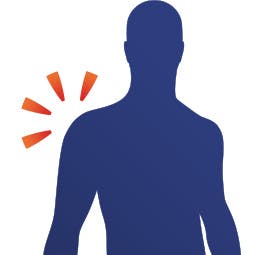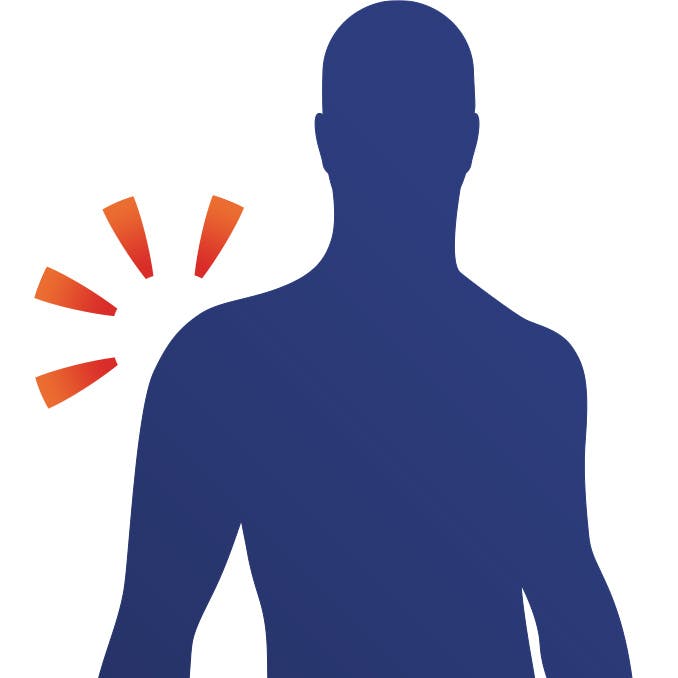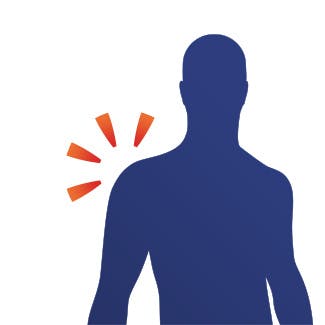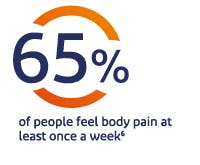Get a better understanding of why our bodies experience the sensation of pain and the many causes of body pain.
Defining body pain
Pain is an unpleasant sensation that can limit a person’s capabilities and abilities to follow a daily routine. It often acts as an early warning signal to alert you that something is not right with your body.[58] The widely accepted definition of pain was developed by the International Association for the Study of Pain: “Pain is an unpleasant sensory and emotional experience that is associated with actual or potential tissue damage or described in such terms.”[58]
Body pain can range from mild, localised discomfort to agony. It can be acute and short-lived, or become a chronic long-term problem. Acute pain has a protective function for humans, it teaches us to avoid bodily damage or potentially damaging situations and protects the injured body part while it heals.[59]
Body pain is a common occurrence and can sometimes affect our everyday routines. If pain remains untreated or treated incorrectly, it may become chronic. If this happens, you should consult your doctor. You can learn more about pain types on this page (“typology of pain”).

Did you know?
Body pain is more than just a physical sensation as 67% of people around the world feel it decreases their quality
of life.[7]
Why do we experience pain?
Pain can be an uncomfortable feeling and some people go to great lengths to figure out how to relieve pain. If we couldn’t feel pain, we would be unable to avoid repeated injury or permanent damage to our bodies. Pain evolved as a defence mechanism that alerts us to an injury, thus allowing us to protect our bodies.[60]
Pain is controlled by the nervous system and is a very complex process. It occurs when an external stimulus, for example, touching a hot pan, triggers receptor nerve cells to send messages through your spinal cord to your brain. These receptors can sense heat, cold, light, touch, pressure, and pain. Pain can bring about other physical symptoms, like nausea, dizziness and weakness.
Often, the first impulse when experiencing body pain is to stop moving. Many believe that rest will help recovery, but in fact, sometimes, moderate movement can support a quicker recovery.
Identifying and treating your pain
Pain alerts us to protect ourselves from further harm. However, body pain can also make day-to-day activities difficult and slow down recovery of movement. Perhaps most significantly, it can change your lifestyle and impact your job, relationships and independence. Pain is always subjective and individuals will experience pain in their own way.[58]

Acute pain typically comes on suddenly and is a sign that your body may have suffered damage. It should go away once the injury has healed. Chronic pain lasts longer than acute pain and is sometimes resistant to treatments. It is usually associated with a long-term illness. Unlike acute pain, chronic pain tends to be related to dysfunctions or diseases that linger. If you are concerned you’re experiencing chronic pain, you should consult your doctor.
Treatments for body pain range widely because of all the factors involved in the individual’s experience of pain and its many causes. Pain medication includes NSAIDS (non-steroidal anti-inflammatory drugs), corticosteroids, or analgesic drugs.[61]
Before reaching for a pain relief treatment, like a topical gel or tablet, it is helpful to understand why the pain is occurring, and the best ways to manage it. If in doubt, seek medical advice from your local doctor or pharmacist.














